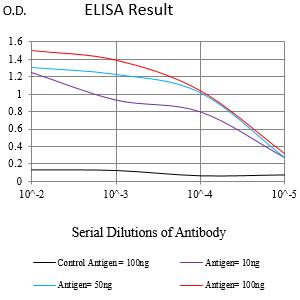
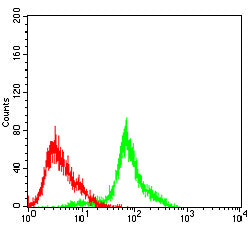
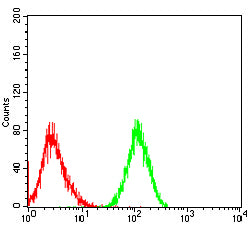
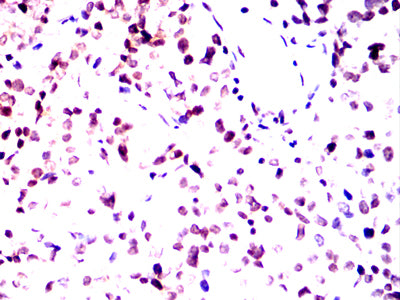
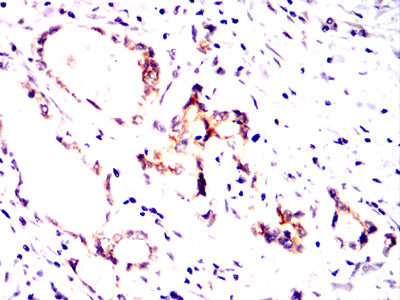
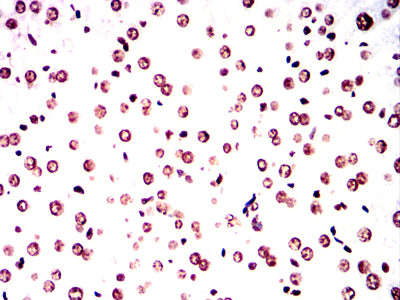
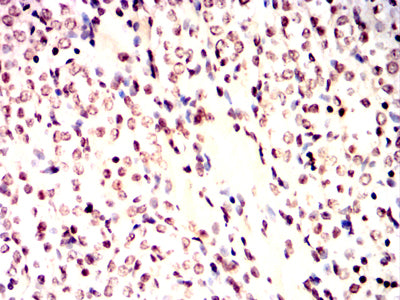
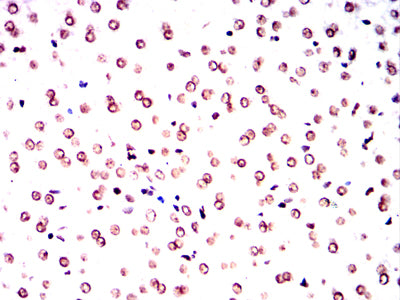
| WB | 咨询技术 | Human,Mouse,Rat |
| IF | 咨询技术 | Human,Mouse,Rat |
| IHC | 1/200 - 1/1000 | Human,Mouse,Rat |
| ICC | 技术咨询 | Human,Mouse,Rat |
| FCM | 1/200 - 1/400 | Human,Mouse,Rat |
| Elisa | 1/10000 | Human,Mouse,Rat |
| Aliases | AT1; ATA; ATC; ATD; ATE; ATDC; TEL1; TELO1 |
| Entrez GeneID | 472 |
| clone | 2A7A10 |
| WB Predicted band size | 350.7kDa |
| Host/Isotype | Mouse IgG2a |
| Antibody Type | Primary antibody |
| Storage | Store at 4°C short term. Aliquot and store at -20°C long term. Avoid freeze/thaw cycles. |
| Immunogen | Purified recombinant fragment of human ATM (AA: 2577-3056) expressed in E. Coli. |
| Formulation | Purified antibody in PBS with 0.05% sodium azide |
+ +
以下是关于ATM抗体的3篇参考文献概览,涵盖其在不同疾病中的检测与临床意义:
---
1. **文献名称**: *Autoantibodies against ATM protein in patients with systemic autoimmune diseases*
**作者**: M. Kurosaka et al.
**摘要**: 该研究检测了系统性红斑狼疮(SLE)和干燥综合征患者血清中的抗ATM自身抗体,发现约15%患者呈阳性。抗体水平与疾病活动性相关,提示ATM抗体可能参与自身免疫病理机制,或作为潜在生物标志物。
---
2. **文献名称**: *ATM gene mutations and serum anti-ATM antibodies in ataxia-telangiectasia*
**作者**: R.A. Gatti et al.
**摘要**: 针对共济失调毛细血管扩张症(A-T)患者的研究,发现ATM基因突变导致蛋白功能缺失,并通过抗ATM抗体检测辅助诊断。该抗体在A-T患者中特异性较高,可用于新生儿筛查及携带者识别。
---
3. **文献名称**: *Anti-ATM antibody as a novel biomarker in chronic lymphocytic leukemia*
**作者**: S. Linley et al.
**摘要**: 研究报道慢性淋巴细胞白血病(CLL)患者中抗ATM抗体阳性率显著高于健康人群,且与ATM基因缺失亚型及治疗耐药相关,提示其可能作为预后评估的补充指标。
---
**注意**:若需具体文献全文,建议通过PubMed或Google Scholar按标题检索。后续研究可关注ATM抗体在癌症、神经退行性疾病及放疗敏感性中的机制探索。
ATM (Ataxia-Telangiectasia Mutated) antibodies target the protein encoded by the *ATM* gene, a critical kinase involved in DNA damage response and genomic stability. The ATM protein is activated primarily by double-strand DNA breaks, initiating signaling cascades that regulate cell cycle checkpoints, DNA repair, and apoptosis. Mutations in *ATM* cause ataxia-telangiectasia (A-T), a rare autosomal recessive disorder characterized by neurodegeneration, immune dysfunction, and cancer predisposition.
ATM antibodies are essential tools in research and diagnostics. They enable detection of ATM expression levels, phosphorylation status (e.g., at Ser1981. a marker of activation), and interactions with repair proteins like BRCA1 or p53. These antibodies are used in techniques such as Western blotting, immunohistochemistry, and immunofluorescence to study ATM's role in cancer biology, aging, and radiation sensitivity.
Clinically, ATM antibodies help identify A-T patients and assess ATM dysfunction in cancers, particularly breast and hematological malignancies. Dysfunctional ATM is linked to chemotherapy resistance, making its detection relevant for personalized treatment strategies. However, challenges remain in standardizing antibody specificity across assays. Ongoing research focuses on developing therapeutic inhibitors targeting ATM pathways to sensitize cancer cells to radiation or DNA-damaging agents. Overall, ATM antibodies bridge molecular insights into genome maintenance mechanisms and their translational applications in human diseases.
×